CSotD: Funnies, with a hat trick
Skip to comments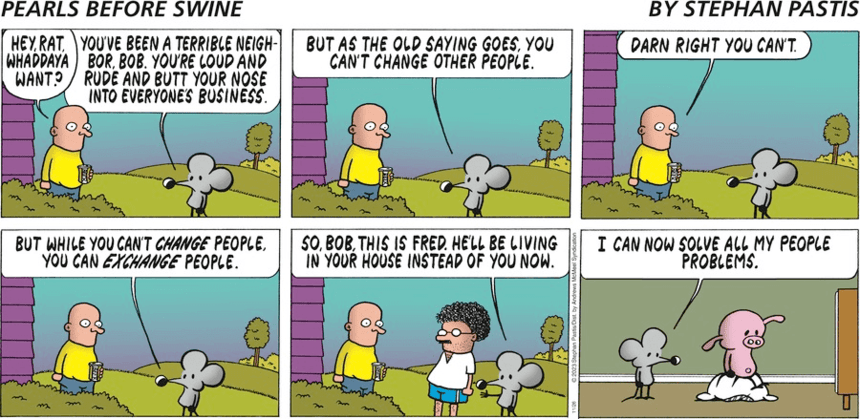
In today’s Pearls Before Swine (AMS) Rat is a bit more proactive than most of us in dealing with neighbor issues, but, then, Rat has never been a model of patience.
I particularly liked the cartoon because I’ve just set a new record, going over 13 years of living in the same house. In both cases, all my immediate neighbors changed over time except one couple in Colorado who were so quiet that it hardly mattered.

Which cancels out the church across the street from my current place, which left in the middle of the night in dramatic fashion.
It’s a good argument for staying in one place, although, as said, it requires patience. I’ve lived in about 20 different places, excluding some college flops, so the fact that I’ve spent 26 of my years in just two of them shows that I’ve pondered the matter from both sides.
Probably also shows how often I was the obnoxious neighbor who moved away.
Juxtaposition of the Day
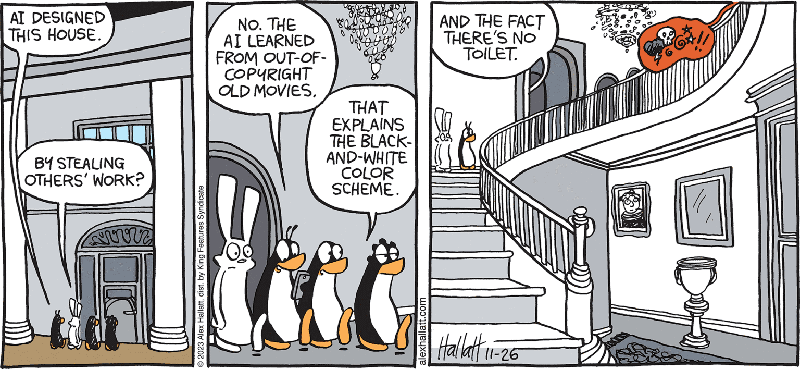
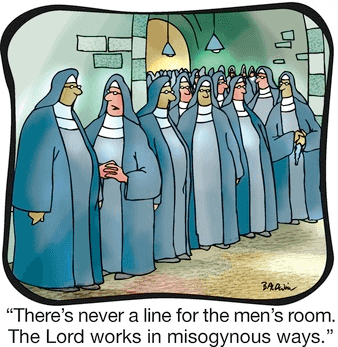
As far as I can recall, Arctic Circle is correct that there were no toilets in old movies, Alex Hallatt being careful to say “toilet” and not “bathroom,” since there were plenty of scenes of people shaving or applying makeup at sinks. But I don’t recall so much as a hint of a water closet in any of those shots.
I use the term “water closet” because that’s what toilets are called in the International Building Code, which brings us to Cornered, because until relatively recently, there was no obligation under the IBC for public buildings to have restrooms for women.
And I use the term “restroom” as a euphemism based on stores at the turn of the 20th century which not only chose to provide facilities for women but fixed them up with couches, suggesting that there were certain times a woman might feel the need to get off her feet as well as to use the water closet.
Yet, as Mike Baldwin’s nun points out, women often find a lack of potty parity, and our leaders are greatly to blame: Pat Schroeder raised the issue as a young Congressional rep back in the early 70s because the Capitol was built with the assumption that no women would need a water closet.
I have no idea what these legislators’ secretarial staff was supposed to do for all those years, though I suppose when it was built, they were mostly male as well.
But times have changed, and the — I kid you not — American Restroom Association has this rundown on the issue of potty parity. It’s all very interesting, but it hasn’t solved the problem of women standing in long lines while men don’t.
The problem is not the code, according to Jennifer Hendricks, a professor at the Colorado University Law School, but hidebound, impractical interpretation of the code by local bureaucrats, and her paper on the topic is a great deal more entertaining than you might expect.
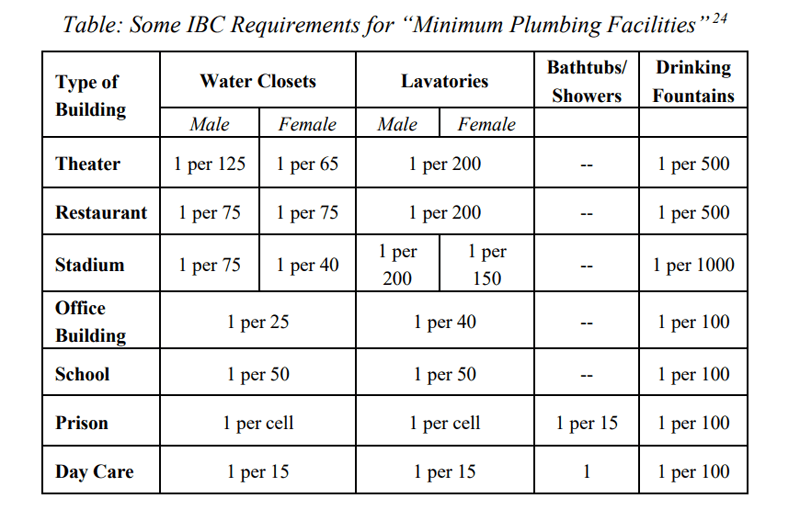
Her main point is that, while the IBC specifies numbers by each sex, it does not require segregation by sex, and unisex facilities would solve not only the lines/no lines issue but issues of gender identity as well.
I’m not sure why she thinks such things should be interpreted sensibly, but she does.
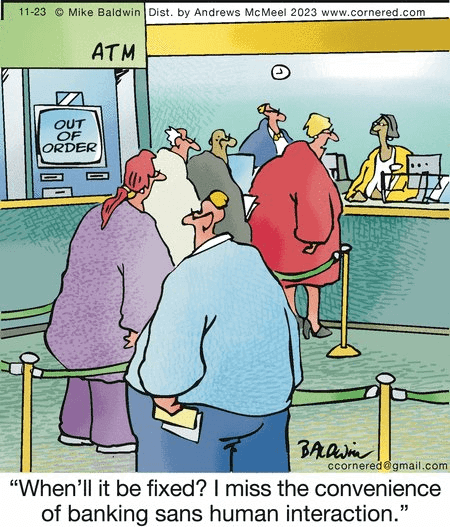
Mike Baldwin was on a hot streak this past week, or at least he was on a streak of hitting my sore spots, and this one landed, as it happens, the morning after a day in which I observed that there were three cars lined up at the teller window in the bank drive-up but nobody at the drive-up ATM.
Which suggests that those people who complain about self-check machines in stores are either in good company (polls suggest they are not) or they prefer waiting in lines to using machines (which I greatly suspect).
BTW, I have often suggested to people who complain about self-check that they (A) stop using ATMs, (B) stop pumping their own gas, and (C) get over themselves.
But I have figured out the solution: Most stores also have a service where they will gather your groceries and bring them out to your car, preserving at least one and probably two jobs. Then the only scary machine involved is the swipe-card reader you’ll use to pay for the groceries, though I suppose they take cash and checks.
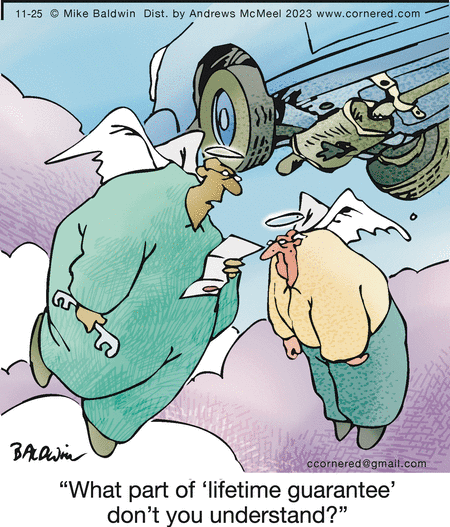
Baldwin goes for the hat trick with the theological question, “Do they have muffler shops in heaven?”
One of the first things young car owners learn is that the lifetime guarantee only covers the muffler itself and none of the expensive pipes, connectors and hangers that invariably are found to also be worn out and requiring replacement.
Which is why I’m pretty sure that, if you see a muffler shop, you didn’t wind up in heaven.
Juxtaposition of Why Some People Deserve to Go to Hell

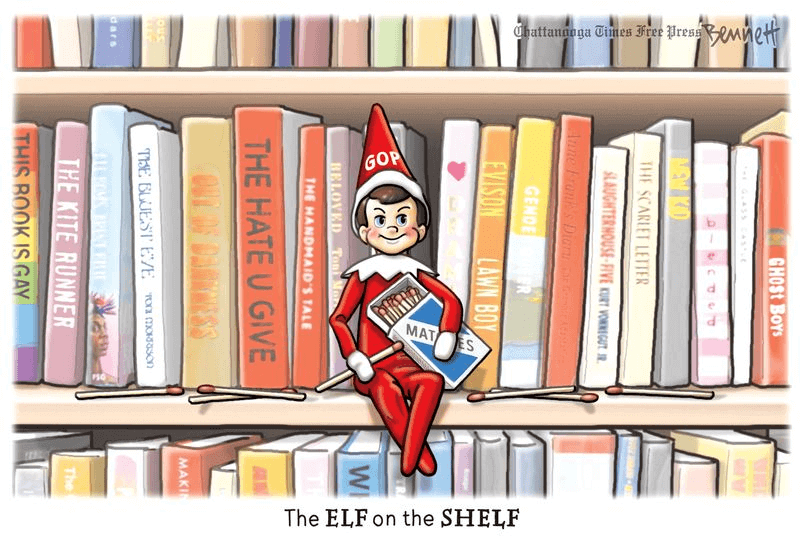
My mother was traumatized when she learned about Santa, less, I think, because she needed him to be real than by the fact that she’d been lied to by people she loved and trusted.
As a result, any questions from us, for instance, about how he could come down the chimney when we didn’t have a fireplace were answered with “Well, what do you think?”
Not only did she let us figure it out for ourselves, but she certainly didn’t use Santa as a threat, and wit all doo respeck to Wanda MacPherson, when you hit that level, you’ve already lost the game.
Elf on the Shelf, though, takes bad parenting to a thermonuclear stage, combining guilt and threats with dishonesty by moving the damn thing around for weeks to create the impression that it’s alive. It’s like filling an Advent calendar with ex-lax.
Which makes me love Clay Bennett’s use of the little monster as a stand-in for the Moms For Hate or whatever they call themselves.
If his cartoon doesn’t make you laugh, read this news story about the rightwing fascisti who, having been voted off their local school board by the decent people, tried to give their superintendent-ally a $700,000 golden parachute, after costing local taxpayers $1.5 million in ridiculous lawsuits.
Boy, has Santa got a load of coal for them!

Comments 10
Comments are closed.